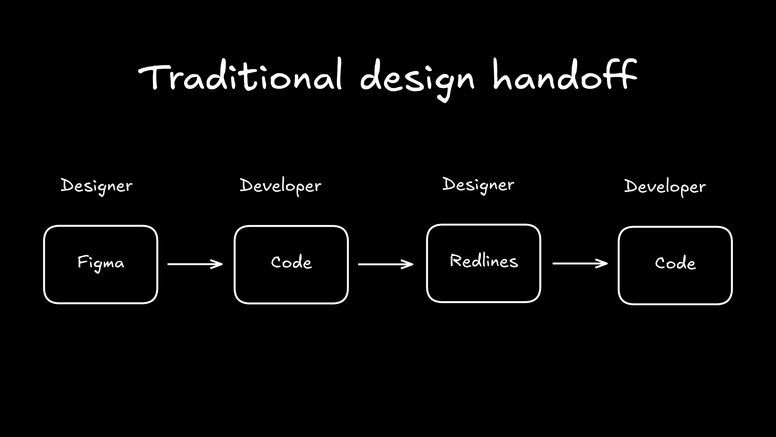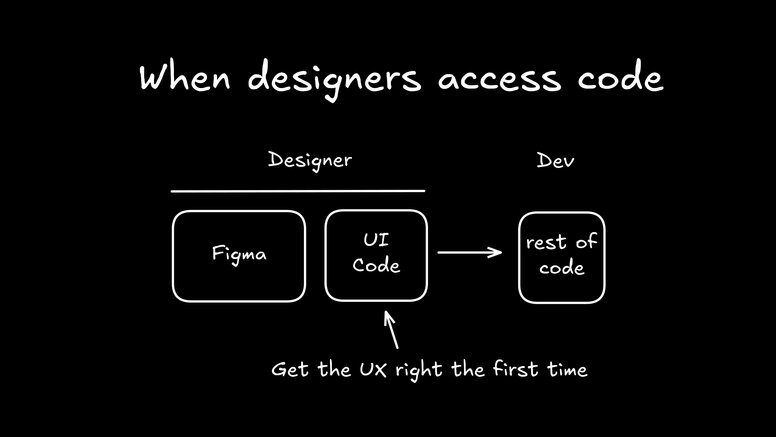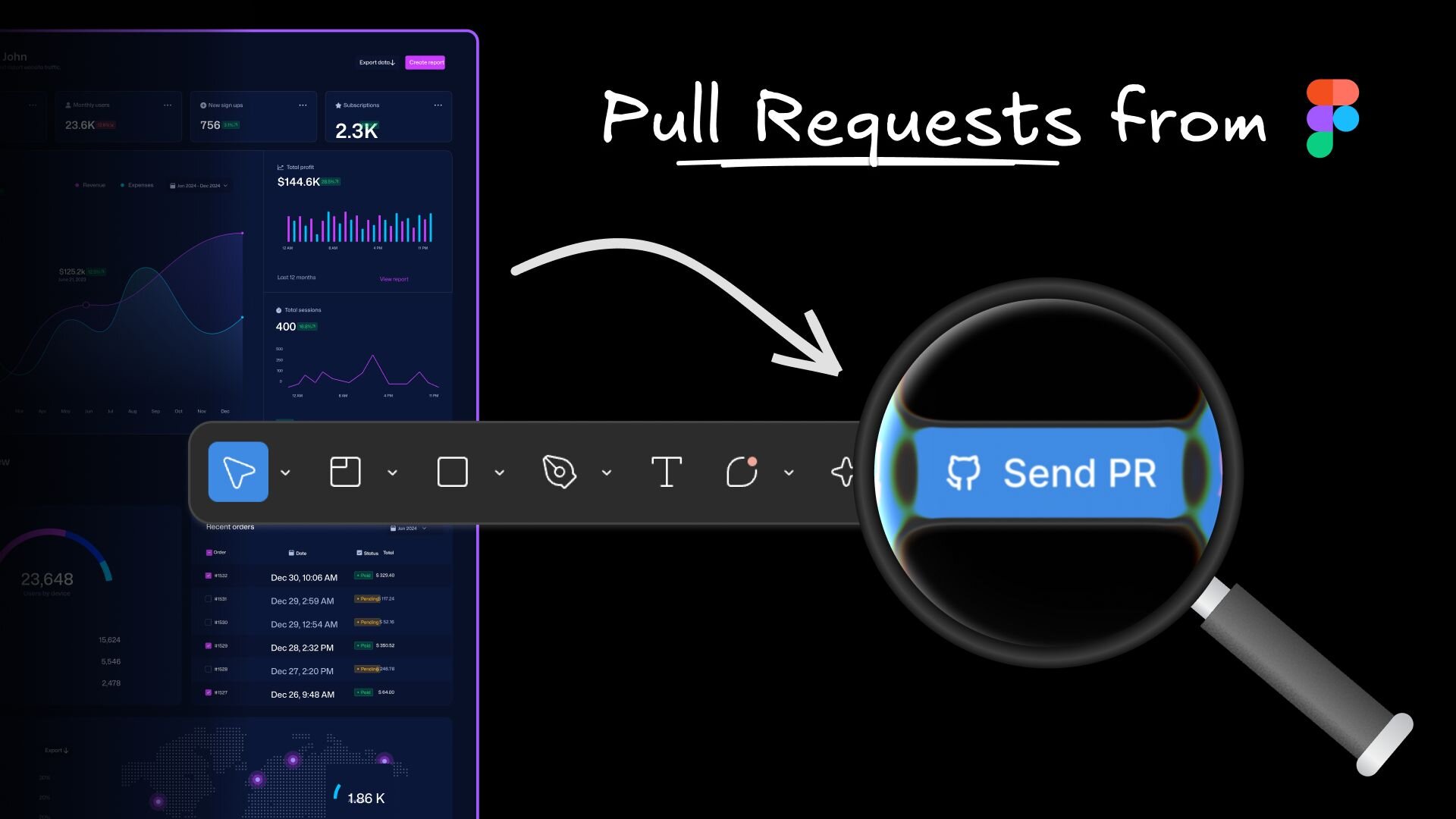Everyone's talking about designers learning to code. Designers picking up React. Designers spinning up databases. Designers becoming builders.
That's real, and it's important. But there's another movement happening that's just as radical: codebases are learning to speak designer.
Design and development are converging. But unlike what most people assume, it's not just designers moving toward code. The tools themselves are meeting designers where they are.
Right now, there are two ways designers are becoming builders:
Path 1: The designer becomes technical. This is what everyone's talking about. Learn Figma Make. Spin up a Supabase backend. Understand databases. Ship products solo. It's powerful, and for many designers, it's the right path.
Path 2: The codebase becomes accessible. This is newer. Instead of designers learning to code, what if the codebase could understand design? What if you could edit production components visually? What if AI could translate between design intent and code implementation, like Fusion does?
Think about it. A Figma file contains everything needed to build a UI. The layout logic. The component structure. The styling rules. The responsive behavior. It's all there, encoded in a different language. What if we could just... translate it?
Both paths lead to the same place: designers who ship. But they work for different people in different situations.
If you're a solo founder or small startup, Path 1 might be your move. Learn the tools, own the stack, ship fast.
If you're on a larger team with existing codebases and design systems, Path 2 opens up something interesting. You don't have to start from scratch. You can work with what's already there.

Let's be honest about what really breaks in the traditional design to development workflow. It's not that developers can't build what designers create. It's that every handoff is a translation between languages that don't quite map to each other.
"Make the padding feel more breathable." "The hover state should be more subtle." "This doesn't feel quite right on mobile."
These aren't technical problems. They're translation problems. The designer sees something specific in their mind. They create it in Figma. The developer interprets it into code. Something always gets lost.
The spacing that looked perfect in the mockup feels cramped in the browser. The animation that was smooth in the prototype feels janky in production. The responsive behavior that made sense in theory breaks at weird viewport sizes.
Every handoff creates drift. And that drift compounds. Six months later, your design system in Figma looks nothing like your design system in code.
So how are teams adapting to solve this?

The most interesting teams I'm seeing now don't divide neatly into "designers" and "developers." They're forming new patterns:
The overlap model: Everyone has a specialty, but skills bleed across boundaries. The designer understands enough about components to edit them directly. The developer has opinions about user experience. The PM can actually build simple features.
The amplified solo: One person with AI assistance can now do what used to take a small team. Not because AI replaces anyone, but because it handles the translation layer. A designer can describe what they want and get working code. A developer can sketch an idea and get a polished interface.
The review-based workflow: Instead of handoffs, everything becomes a review. Designers create pull requests. Developers review them for code quality. But the implementation already exists. You're reviewing something real, not debating something theoretical.
Tools like Fusion fit into this pattern. Connect your codebase, import your Figma designs, and the AI translates between them. But it's not about the tool. It's about what the tool enables: designers who can implement their own vision.
Here's what this looks like in practice at Builder.
Something fundamental shifts when designers can directly edit what users will actually see. Here's what happened with our own team.
Our product designer had been sitting on ideas for the landing page hero section for days. Not because the ideas weren't good. Not because anyone disagreed with the vision. But because every developer who could implement it was deep in feature work. You know how it goes. The roadmap is packed. The sprint is full. That "quick" homepage update keeps getting pushed to next week.
The designer could have created another Figma mockup. Could have added it to the backlog. Could have waited for the next planning session to advocate for the work. Instead, they tried something different.
They opened up our landing page in Fusion, described what they wanted in plain English, and started visually editing the generated components. Real code. Real components. The actual hero section visitors would see. They could test different layouts with production data, see how it responded across breakpoints, and refine the design while looking at the real thing.
The whole update took an afternoon. Not two sprints. Not when developers finally had bandwidth. An afternoon. The designer created a PR, the team reviewed it, and it shipped. The developers stayed focused on the features that actually needed their expertise.
This is Builder's story. Our own product designer shipping our own hero section. Without writing code. Without waiting for developer availability. Without the usual back-and-forth.
This shift requires new skills.
Here's what's wild. The most valuable skill for a designer today isn't learning React syntax. It's understanding how systems work.
Can you think in components? Do you understand why certain patterns exist in your codebase? Can you spot when something will be technically complex even if you can't implement it yourself?
A designer who understands that their beautiful gradient will tank performance on mobile is more valuable than one who can write CSS but doesn't think about systems.
Similarly, developers who embrace this shift aren't threatened by designers touching code. They're excited about it. Finally, they can focus on architecture, performance, and complex business logic while designers handle the visual refinements directly.
The curiosity to cross boundaries matters more than expertise in any particular domain.
Let me paint you a picture of how this works in practice.
You're a designer. You've just created a new feature flow in Figma. Three screens: a form, a confirmation, and a success state. In the old world, you'd annotate everything, write up interaction notes, and hand it off.
In the new world? You connect your Figma file to your actual codebase. The AI understands your existing design system. It sees you're using your standard button component, your common form patterns, your established spacing tokens.
It generates code that uses your actual components. Not generic HTML. Not a close approximation. Your actual Button component with the right props. Your actual form validation patterns. Your actual routing logic.
You can see it running immediately. Real code in a real environment. Something feels off? Adjust it visually. The spacing needs work? Edit it directly. The hover state isn't quite right? Fix it in place.
When you're happy, you create a pull request. Just like any developer would. Your team reviews it. They might suggest improvements. But you're all looking at the same thing: working code.
This shift is just beginning. The tools will keep getting better. Figma Make will mature. Fusion and similar tools will get smarter. New approaches we haven't imagined yet will emerge.
But the direction is clear. The boundary between design and implementation is dissolving. Not because everyone needs to become a full-stack engineer. But because the translation layer is disappearing.
If you're a designer reading this, here's my advice: Don't panic about learning to code. Instead, focus on understanding systems. Learn how components work in your codebase. Understand what makes implementation complex. Get comfortable with git workflows.
Most importantly, start touching production. Whether that's through visual tools, AI assistance, or yes, learning some code. The specific path matters less than the destination: becoming someone who ships.
If you're a developer, embrace the designers who want to contribute to code. Help them understand the patterns. Review their PRs with the same care you'd review anyone else's. Learning is quick when everyone can see the immediate impact of their changes.
The designer who ships beats the designer who hands off. Every time. And now, for the first time, shipping is within reach for every designer who wants it.
Your Figma file contains all the information needed to build your UI. The layout, the logic, the styling, the interactions. It's all there. With the right tools and mindset, that file isn't just a mockup anymore.
It's production code. You just need to deploy it.
Builder.io visually edits code, uses your design system, and sends pull requests.
Builder.io visually edits code, uses your design system, and sends pull requests.




 Connect a Repo
Connect a Repo








